HOW TO CHECK WHICH TYPE OF DECIMAL EXPANSION
Subscribe to our ▶️ YouTube channel 🔴 for the latest videos, updates, and tips.
If a rational number p/q, q ≠ 0 can be expressed in the form p/(2m x 5n) , where p ∈ Z and m, n ∈ W, then rational number will have a terminating decimal expansion.
Otherwise, the rational number will have a non- terminating and recurring decimal expansion
Question 1 :
Express the following rational numbers into decimal and state the kind of decimal expansion
(i) 2/7
Solution :
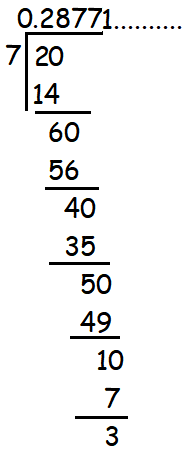
2/7 = 0.28771...........
Hence the given fraction will have non terminating and recurring decimal expansion.
(ii) -5 3/11
Solution :
-5 3/11 = - (55 + 3)/11 = -58/11
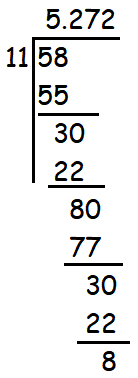
-58/11 = 5.2727..........
Hence the given fraction will have non terminating and non recurring decimal expansion.
(iii) 22/3
Solution :
22/3 =
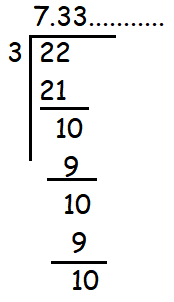
Hence the given fraction will have non terminating and recurring decimal expansion.
(iv) 327/200
Solution :
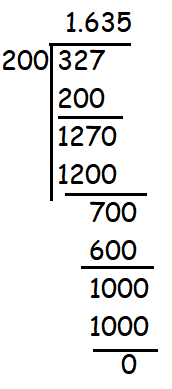
Hence the given fraction will have terminating decimal expansion.
How to Find Length of Period of Decimals
Question 2 :
Express 1/13 in decimal form. Find the length of the periods of decimals.
Solution :
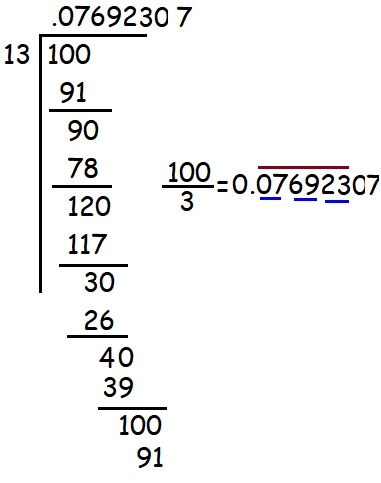
Hence the length of period is 6.
Question 2 :
Express the rational number 1/33 in recurring decimal form by using the recurring decimal expansion of 1/11. Hence write 71/33 in recurring decimal form.
Solution :
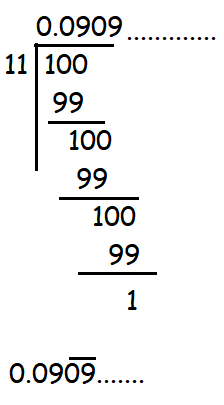
1/11 = 0.0909..........
1/33 = (1/3) (1/11) = (1/3)(0.0909......)
1/33 = 0.0303...........
71/33 = 71(1/33)
= 71(0.03 bar)
= 2.15 bar
How to Express the Decimals as Fractions
Question 3 :
Express the following decimal expression into rational numbers.
(i) 0.24 (bar)
Solution :
Let x = 0.242424............ -----(1)
Since we have the sign bar for two digits, we have to multiply (1) by 100 on both sides.
100x = 24.2424...........------(2)
(2) - (1)
100x - x = 24.2424......-0.2424...........
99x = 24
x = 24/99
x = 8/33
Hence the rational form of the given decimal is 8/33.
(ii) 2.327 (bar)
Solution :
Let x = 2.327327............ -----(1)
Since we have the sign bar for three digits, we have to multiply (1) by 1000 on both sides.
1000x = 2327.327327...........------(2)
(2) - (1)
1000x - x = 2327.327327.....-2.327327........
999x = 2325
x = 2325/999
x = 775/333
Hence the rational form of the given decimal is 775/333.
(iii) -5.132
Solution :
The given decimal is terminating decimal. We have three digits after the decimal. So, we have to multiply the numerator and denominator by 1000.
-5.132 = -5132/1000
= -2566/500
= -1283/250
(iv) 3.17 (bar) (bar is only for 7)
Solution :
Let x = 3.177777........... -----(1)
Since we have the sign bar for only one digit, we have to multiply (1) by 10 on both sides.
10x = 31.77777...........------(2)
(2) - (1)
10x - x = 31.7777.....-3.17777........
9x = 28.6
x = 28.6/9
Multiply both numerator and denominator by 10.
x = 286/90
x = 143/45
Hence the fractional form of the given decimal is 143/45.
(v) 17.215 (bar is for 1 and 5)
Solution :
Let x = 17.2151515........... -----(1)
Since we have the sign bar for two digits, we have to multiply (1) by 100 on both sides.
100x = 1721.51515...........------(2)
(2) - (1)
100x - x = 1721.51515.......... - 17.2151515...........
99x = 1704.3
x = 1704.3/99
Multiply both numerator and denominator by 10.
x = 17043/990
x = 5681/330
Hence the fractional form of the given decimal is 5681/330.
(vi) -21.2137 (bar is for 7)
Solution :
Let x = 21.213777........... -----(1)
Since we have the sign bar for two digits, we have to multiply (1) by 100 on both sides.
10x = 212.137777...........------(2)
(2) - (1)
10x - x = 212.137777........... - 21.213777...........
9x = 191.92
x = 191.924/9
x = 190924/9000
x = 47731/2250
Let see the next concept on "How to Check Which Type of Decimal Expansion".
How to Check if the Fraction has Terminating Decimal ?
Question 4 :
Without actual division, find which of the following rational numbers have terminating decimal expansion.
(i) 7/128
Solution :
128 = 27
7/128 = 7/27
Since the denominator is in the form 2m x 5n, the given fraction is terminating decimal.
(ii) 21/15
Solution :
21/15 = 7/5
Since the denominator is not in the form 2m x 5n, the given fraction is non terminating decimal.
(iii) 4 9/35
Solution :
4 9/35 = 149/35
35 = 7 x 5
Since the denominator is not in the form 2m x 5n, the given fraction is non terminating decimal.
(iv) 219/2200
Solution :
2200 = 52 x 23 x 11
Since the denominator is in the form 2m x 5n, the given fraction is non terminating decimal.
Subscribe to our ▶️ YouTube channel 🔴 for the latest videos, updates, and tips.
Kindly mail your feedback to v4formath@gmail.com
We always appreciate your feedback.
About Us | Contact Us | Privacy Policy
©All rights reserved. onlinemath4all.com

Recent Articles
-
US Common Core K-12 Curricum Algebra Solving Simple Equations
Jan 07, 26 01:53 PM
US Common Core K-12 Curricum Algebra Solving Simple Equations -
10 Hard SAT Math Questions (Part - 4)
Jan 05, 26 06:56 PM
10 Hard SAT Math Questions (Part - 4) -
10 Hard SAT Math Questions (Part - 3)
Jan 05, 26 06:34 PM
10 Hard SAT Math Questions (Part - 3)

